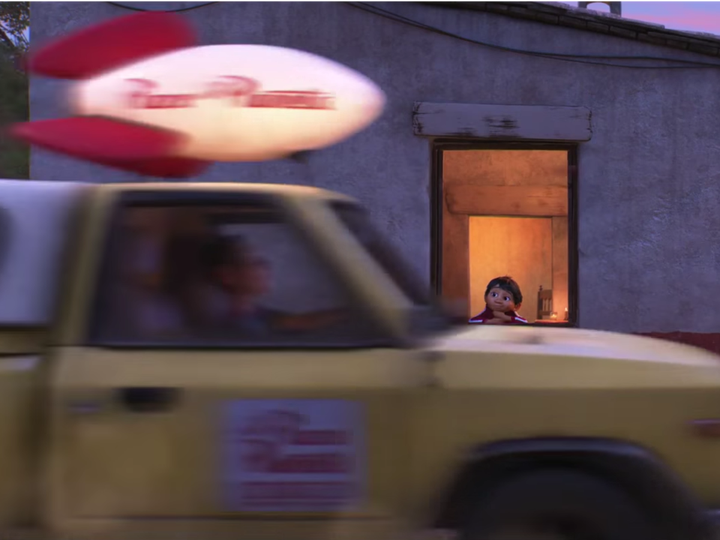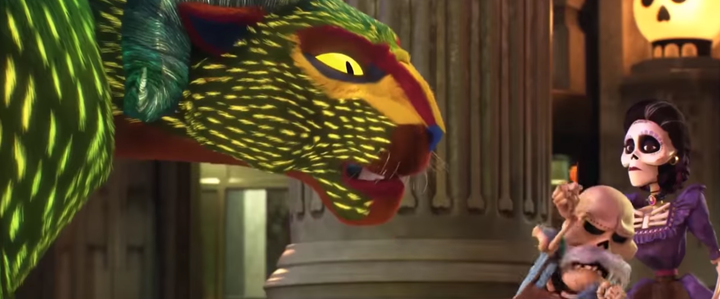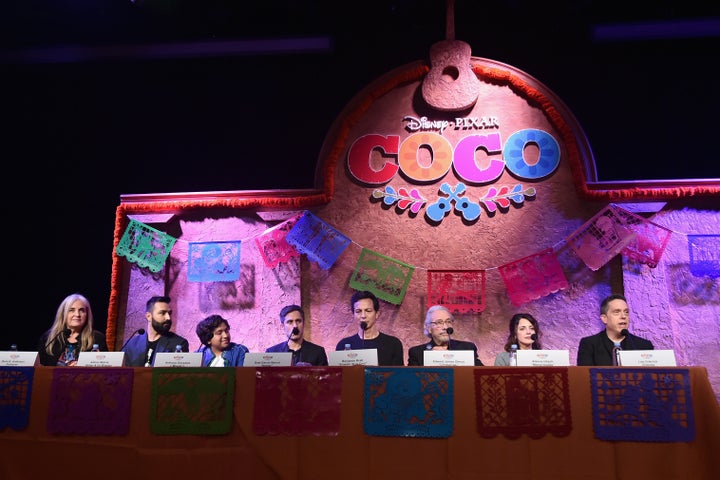If there’s one thing that connects people everywhere, despite their differences, it’s a love of pizza. So it makes sense that one of the things linking movies in the Pixar universe is the Pizza Planet truck.
Since it was introduced in “Toy Story,” the iconic truck has served as a perpetual Easter egg, popping up ― sometimes subtly ― in various scenes as connective tissue across Pixar’s universe.
The truck aptly makes an appearance in Pixar’s new movie, “Coco,” when it speeds by the screen as Miguel looks out a window. But don’t be fooled, the scene features a small but telling change. And it’s nearly impossible to observe, even when you’re looking at a still image:
The truck doesn’t say Pizza Planet. It says “Pizza Planeta.”

Pizza Planet’s switch to Spanish makes sense for the movie, which takes place in Mexico, and cleverly embeds “Coco” in the world of Pixar in the process.
During an interview with HuffPost, co-director Adrian Molina talked with us about the subtle change to one of Pixar’s most iconic staples.
“Every single thing that we create in our film we create from scratch, so if we want every element of this film to feel like part of this world, then we’ve got an entire team of artists whose job it is to create those details,” Molina said. “You see it in the attic scene with Miguel’s guitar. The spine of that guitar says something about the time he’s put into it, and every object has a history.”

“So something like if there’s a Pizza Planet in Mexico, it’d probably be Pizza Planeta,” he said, “because I imagine at this point it must be an international chain. In Mexico, that would be how they outfit all of their trucks.”
Molina and writer Matthew Aldrich opened up about a variety of “Coco” secrets, including changes the story went through and an admittedly “shitty” situation involving the movie’s name:
Yes, that murder plot was discussed.
Without giving too much away, there’s a murder storyline in “Coco”—which, we remind you, is a Pixar movie. It’s a dark and surprising moment, and Molina told us there was some talk about whether to include it.
“There had been discussions in the story room over whether that was necessary,” he said. “For me, the drama, that’s the juicy stuff, and we wanted to be very delicate in how we presented it, but it’s also this story about where your values are and the things you’re willing to do to get what you want. That storyline very much plays into the endgame in term of themes for how a person with a lot of ambition could take that too far.”
Aldrich said the murder plot never left the story and seemed like it fit in perfectly with the tale they were trying to portray.
“It was the way the mystery would sort of be revealed,” he said. “I have to say, for me, one of the things that I like about it is it’s a great moment ― it’s dark, it’s surprising and it has this wonderful touch of melodrama that reminded me of the great telenovelas and these big reveals.”
Pepita went through a lot of changes.

One of the scene stealers in “Coco” is the cat-dragon monster-like alebrije, aka spirit guide, Pepita. Aldrich told us that Pepita took many shapes over the years.
“I think we decided early on that everybody gets a spirit guide,” he said. “So we figured, hey, if everybody gets one then Mama Imelda gets one, too, and what would hers be like? We went from there. How much or little Pepita factored into the plot ebbed and flowed through the many versions. I loved where she ended up.”
The writer loved Pepita so much, in fact, that despite being one of the creators of the story and the character, he went out and bought a stuffed Pepita toy for his goddaughter, rather than just getting one from Disney or Pixar.
Reflecting on that, Aldrich told us: “Maybe I should’ve asked somebody.”
Frida Kahlo’s appearance was a chance to explore Mexican history.
A character representing Mexican artist Frida Kahlo plays a substantial role in “Coco,” and Molina told us that was because the movie gave the creators the “once in a lifetime opportunity to discuss artists from Mexican history and meet them.”
“She became the first person to root for Miguel or to give him a model of someone who used their art to change the world, because that’s what he’s kind of searching for is that role model, that mentor,” Molina said. “When he enters the land of the dead, we thought, ’Oh, what a perfect opportunity for him to meet Frida Kahlo and her recognize this sense of him being an artist and that being the thing that leads him in his pursuit to get to the musician that he idolizes.’”
The name Coco had an important meaning for Aldrich.

Aldrich says the name Coco “had been floating around in various forms for a while,” and when it finally landed on Mama Coco, “it just stuck. It felt right. It’s endearing.”
For the writer, the name reminded him of his own family.
“I have in my own family, my great-grandparents, they’re Italian, and so we called them Nonna ... and it sort of reminded me of that. It had the same sort of sound and cadence.”
But “Coco” has a very different meaning for the people of Brazil ...
In Brazil, coco, with emphasis on the last o, means “shit.”
Molina said the filmmakers were well aware of that.
“It came up in meetings where we were talking about localization for different areas, and so knowing that the name has been changed in Brazil. I believe her name is Lupita,” he said.
“We understandably changed some names,” Molina added, “but I think the relationship remains essential to the story in all languages.”
Pixar’s new movie is definitely the “Coco.”

